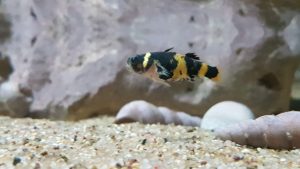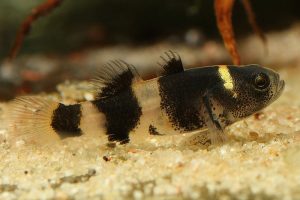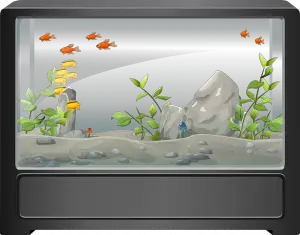Bumblebee goby is one of our favorite fishes. These interesting and adorable little critters steal the show in almost every aquarium, and we’ve heard from countless owners who can’t stop talking about them.
But there are some aspects of bumblebee goby care that you’ll need to be comfortable with if you’re planning on getting one for yourself. These are fish that need brackish water and have specific dietary requirements to thrive.
Luckily, once you know what to do to take care of this fish, it’s much easier. Read on to learn all you need to know.

Taxonomy
Here is the scientific classification of Bumblebee goby
| Scientific classification | |
|---|---|
| Kingdom: | Animalia |
| Phylum: | Chordata |
| Class: | Actinopterygii |
| Order: | Gobiiformes |
| Family: | Oxudercidae |
| Subfamily: | Gobionellinae |
| Genus: | Brachygobius Bleeker, 1874 |
| Type species | |
| Gobius doriae | |
Species
There is no question that the bumblebee goby is a fascinating species to care for. Thanks to their eye-catching looks, these fish have become quite popular with aquarists.
Scientifically, the gobies of bumblebee are known as Brachygobius. Technically speaking, Brachygobius is the name of the genus. There are several types of fish sold under the “Brachygobius” moniker, but the differences are so small that most can’t tell them apart.
The goby bumblebee emerged from Southeast Asia. They are usually found in slow-moving streams and tributaries around Indonesia, Vietnam, and Thailand.
Although this species of fish in the fish world is highly sought-after, they are not the easiest to care for. Bumblebee gobies require to survive in a carefully developed environment and a high-quality diet. If you’re looking for a piece of cake that doesn’t require any effort, this isn’t the fish you ‘re looking for.
Bumblebee goby Lifespan
Under normal conditions, the average lifespan of the bumblebee goby is about three years. This is mainly due to the specific needs of this species for care in captivity.
These fish are, however, able to live a bit longer. Some aquarists saw their gobies being four years old or older live!
It is only possible by offering high-quality, extremely reliable treatment (with an added bonus of strong genetics). Not only do owners need to work hard at all times to maintain water conditions, but they also need to give them a comfortable and stress-free life.
Appearance

The trade name given to those fish does quite a good job of describing their physical appearance. The first thing that you will notice is its distinct striped pattern. The alternating black and yellow stripes cover all of their bodies.
The yellow stripes’ exact hue can vary a bit between fish and fish. Some specimens may have pale yellow patterns whilst others may lean more to the orange side. It is typically the male fish that is the most vibrant.
Bumblebee gobies have that iconic “goby” form when it comes to shape. They have relatively slender bodies and small heads. Males tend to be slightly slender than females. Both have an identical round head and bulbous eyes, though.
The fins are mostly transparent. The fins have a bit of black in them on some fish too. Usually, the corresponding stripe is an extension.
You may want to check out these articles:
Bumblebee goby Size
Those fish are by no means very big. The average bumblebee goby size at full maturity is only about one and a half inches long! Some don’t make it to that either.
This species is a great choice for anyone looking for an interesting nano fish, because they are so small. Even if you’re trying to maximize their lifespan, you ‘re probably going to want a slightly bigger setup than this.
Bumblebee goby Care
As we mentioned earlier, the care of bumblebee gobies can be a bit tricky. This species needs a little more work than just a Goldfish or some other straightforward species.
With that said, it’s manageable to care for this quirky fish. The key is to get a strong understanding of their specific needs and provide optimal living conditions for them.
Tank size

This is a very common question most of the aquarists ask. Tank size is one of the easiest things to manage. Bumblebee gobies in a standard 10-gallon tank are doing just fine. You can keep several fish in a single 10-gallon nano tank without problems, thanks to their small size.
The fish can stay happy and healthy in close quarters, as long as the tank is not overcrowded.
Water Parameters

In this section, we will be talking about the water parameters for bumblebee goby! Here is where things get a little tricky. Bumblebee gobies are found naturally in somewhat brackish ponds. Some fish will require low levels of salinity to stay healthy in their tanks. Others could do well in pure freshwater.
When you buy bumblebee gobies, it ‘s important to get more information about how you raised them. Although many breeders stick to a brackish setup of water, there are some out there who managed to raise and breed the fish without any salt whatsoever.
The water quality in which the fish were raised must match your tank. Otherwise, you’ll probably shock their system which will eventually lead to death.
Bumblebee gobies are relatively hardy, beyond the salinity levels. They love alkaline water and warm temperatures. Here are the parameters that should keep an eye on:
- Water temperature: 72 to 84 degrees Fahrenheit (73.5 to 79 degrees is ideal)
- pH levels: 7.0 to 8.5
- Water hardness: 9 to 19 dKH
- Water salinity: 1.002 to 1.006 salt grade
In the aquarium
Bumblebee gobies are popular fish in aquariums. A tank sized around 40 liters will comfortably house a dozen specimens. They can live in an aquarium for around five years under good conditions.
The most commonly traded species in the hobby belong to the doriae-species group of Brachygobius but the smaller Brachygobius nunus is also occasionally traded. Although many books on aquariums use the name Brachygobius xanthozona, this species is very rare in the wild and is not traded commercially.
What to put in their tank?

Like any fish, their natural environment is best imitated. Bumblebee gobies are found in the ponds and streams, where they enjoy tons of hiding spaces.
Start with a pretty sandy substrate. These are bottom-feeder fish which tend to spend time close to the substrate. Some bumblebee gobies even love digging a bit into the sand. A thick, chunky substrate like gravel would make it difficult and pose a risk of injury.
Next, they provide lots of natural decorations. At first, those criteria can be a bit skittish. This is particularly true when they are sharing a tank with other fish. Hiding spots can help them feel secure and calm.
Use all of the plants, rocks, and driftwood. Items such as hides of coconut or ceramic tubes are also highly appreciated.
Once you’ve planned everything you need to set up the filtration system accordingly. Before adding the fish, tanks should be cycled completely. This will give you the opportunity to fine-tune the water quality.
A standard sponge filter you’ll do hanging inside or outside the tank. The main thing that you need to worry about is how water flow affects the tank.
Feeding and Diet
Wondering what to feed your bumblebee goby? We have got this covered! Here is another tricky piece about owning gobies for bumblebee. They can be challenging eaters!
Most won’t take even a bite of dry food. They are carnivores, who rely on a diet rich in proteins. That means you’ll have to invest in live or frozen quality food to keep your fish healthy.
Bloodworms, daphnia, and worms with tubifex are great options. Also, many aquarists provide brine shrimp, as they are easy to hatch and grow.
This is one of the bumblebee goby care aspects that discourages many potential proprietors. Luckily, once a system has been figured out for feeding time it won’t seem like such a big deal!
Behavior & Temperament
The bumblebee gobies are generally quite peaceful. They ‘re passive creatures that prefer to hide, rather than show aggression. A certain territorial behavior has been observed with that said.
The fish will generally claim a small portion of the tank as their own and heavily guard it. When another fish of the same species enters, they can spar a little bit. This is usually just light fighting, however, and will never result in serious injury.
Bumblebee gobies do like their own kind of socializing. When they’re kept with other bumblebee fish they do exceptionally well. They’ll be grouping up and swimming around for a while until they’re ready to go their own way.
Bumblebee goby Tankmates
It’s not always easy to find proper tank mates for the bumblebee goby. This is due in large part to their needs for brackish water. Its temperament is never the problem!
The small size of the fish can also make them a target for bigger species. Other fish will compete for the food you supply. They’ll almost always lose those battles because of their small stature.
Many aquarists keep bumblebee gobies in a single-species tank for these reasons. There are several other bumblebee gobies that you can create a small community. For a 10- or 15-gallon tank we recommend a group of about 7 fish.
You can add a few shrimps to the mix too. Stick to big shrimp to make sure the fish don’t see them as food. This means that species such as the cherry shrimp are not a great idea.
So in summary, as viable tank mates, you are looking at other bumblebee gobies or bigger shrimps. In our view, it’s not a good idea to consider other options.
Breeding your bumblebee goby
Egg-layers are the bumblebee gobies. Females may at one-time layover 200 eggs!
It isn’t too hard to trigger the breeding process. Typically, breeders simply provide foods with a higher than normal protein content. Some will add some fresh water to the tank, as well.
You’ll know fish breed when you see females start swelling up. She is going to lay her eggs in tiny hiding places. If you plan ahead, add some smooth ceramic tubes to the tank, or an overturned dome. That is going to be the perfect place to keep your eggs safe.
Drain them from the tank once the eggs are laid. Alternatively, all the adult fish can be moved to another tank.
Males will fiercely watch over the eggs. The eggs will hatch after around a week! You can separate the male at this point so that he does not eat any of the fry.
The frey should be able to swim freely in another week. Feed them with cultures of infusoria until they are large enough to eat shrimp on baby brine.
Our readers also read:
Bumblebee goby Diseases
Diseases with the bumblebee goby can be fairly common. This is usually caused, though, by control of factors owners.
Illnesses are typically caused by stress and poor water conditions. Unfortunately, many fish of this species come down with Ich and other stress-related illnesses because the levels of salinity are not correct.
Fish which have been brought up in brackish water must have some salt. Moving them to a fully freshwater tank sends the body into shock, resulting in the aforementioned illness.
We can’t stress enough how important bumblebee gobies are for water quality. Be watchful of keeping their tank conditions at optimum levels.
Reach your fish supplier in advance and exactly mimic their water conditions.
Freshwater bumblebee gobies are rare even though they exist. If you don’t want to deal with brackish water, you must make sure you are buying from a reputable freshwater breeder. Before you commit, make sure the fish had spent their whole life in freshwater.
Having introduced your fish into their new home, whether it’s brackish or not, keep monitoring the water (make sure to use a good test kit). Perform regular water changes, and don’t forget to test salinity levels if you haven’t bought from a freshwater breeder.
Usually, with nothing more than one teaspoon of salt per gallon you can achieve the desired salinity levels. Exact measurements are of course always best, so regular testing.
If your fish comes down with Ich, then quarantining them as soon as possible is important. The disease is very contagious, and entire tanks have been known to be wiped off. You can use copper-based medicines over-the-counter to treat the affected fish once it has been quarantined.
Conclusion
Due to its unique and cute appearance, tons of people are drawn to the bumblebee goby. They imagine having a ton of these little fish swimming around their tank while they’re sitting back and having fun.
But when they discover some of the care needs they lose interest.
Before considering getting this fish you should consider providing them with proper care if you are willing to. Brackish waters and a live diet can increase quite significantly the amount of time you spend in your aquarium.
If you’re just wanting a low-maintenance and easy-going fish, there’s plenty of other cute fish to consider.
If that doesn’t dissuade you, though, then we encourage you to give it a shot. In our experience, the most rewarding ends up being the fish that require a little extra attention.
With these fish, we have had great experiences, and we know many other owners who feel the same way. We just want to make sure that you have realistic expectations of what it is like to own those fish!
Bumblebee goby care is a unique experience and we know you ‘re going to have a great time if you’re up for the challenge.
Please contact us for feedback and suggestions.


mexico pharmacy: mexican pharmacy – mexican mail order pharmacies
pharmacies in mexico that ship to usa
https://cmqpharma.com/# mexico drug stores pharmacies
mexican pharmaceuticals online
Very interesting topic, regards for posting.Raise your business
buying from online mexican pharmacy: mexican pharmacy – mexican pharmacy
mexican drugstore online mexico pharmacies prescription drugs mexico pharmacy
https://foruspharma.com/# buying from online mexican pharmacy
indian pharmacy online top 10 online pharmacy in india indianpharmacy com
the canadian drugstore: cheap canadian pharmacy – pharmacy rx world canada
top 10 pharmacies in india: india pharmacy mail order – india pharmacy mail order
https://canadapharmast.com/# cheap canadian pharmacy
indian pharmacies safe: top 10 online pharmacy in india – world pharmacy india
mexico pharmacies prescription drugs pharmacies in mexico that ship to usa mexico drug stores pharmacies
canadianpharmacy com: pharmacy wholesalers canada – legitimate canadian pharmacy online
mexico drug stores pharmacies: buying prescription drugs in mexico – buying from online mexican pharmacy
indian pharmacy online: top 10 pharmacies in india – top 10 pharmacies in india
canadian pharmacy mall canadian family pharmacy 77 canadian pharmacy
mexico drug stores pharmacies: buying from online mexican pharmacy – mexican drugstore online
http://canadapharmast.com/# canadian pharmacy antibiotics
https://doxycyclinedelivery.pro/# can you buy doxycycline
https://ciprodelivery.pro/# ciprofloxacin 500mg buy online
http://ciprodelivery.pro/# buy ciprofloxacin
http://amoxildelivery.pro/# amoxicillin 1000 mg capsule
http://amoxildelivery.pro/# can i purchase amoxicillin online
https://doxycyclinedelivery.pro/# doxycycline price south africa
https://amoxildelivery.pro/# amoxicillin from canada
https://doxycyclinedelivery.pro/# price of doxycycline
https://paxloviddelivery.pro/# paxlovid pharmacy